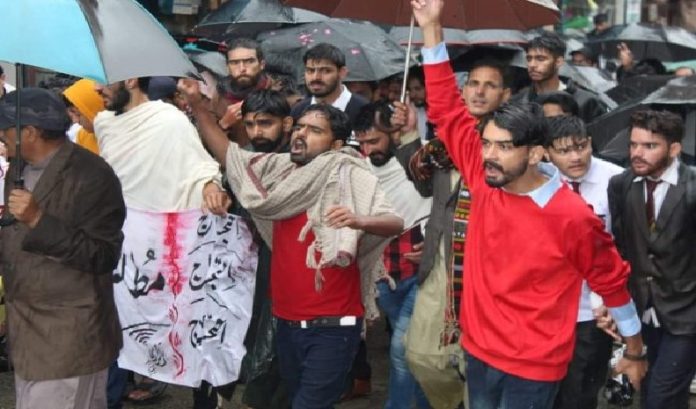Despite heavy rain and cold weather, thousands of students protest in Pakistan occupied Jammu and Kashmir (POJK). These rallies and programs were organized in various districts and town centers, spanning Muzaffarabad, Poonch, and Mirpur divisions, including both small and large markets. Students from Jammu and Kashmir also held protest demonstrations in major cities of Pakistan, such as Islamabad, Lahore, and Karachi.
The protests witnessed significant participation from female students. In addition to voicing their demands, the students chanted slogans in favor of giving control over the region’s resources to its citizens.
Student protest on the call of Awami Action Committee
These demonstrations were organized in connection with the ongoing public rights movement, which has persisted for five months in Jammu and Kashmir. The Awami Action Committee (Jammu Kashmir Joint Public Action Committee) had earlier announced plans for a region wide student protest march on October 17. These marches were coordinated by student organizations within educational institutions, showing solidarity with the public rights movement.
A declaration made at the end of the protests stated that the primary purpose was to express support for the ongoing public rights movement in Jammu and Kashmir. The protest also addressed the issues faced by students in Rawalpindi Islamabad, especially those hailing from Jammu and Kashmir.
One of the key demands was the revival of the Students Union, which is part of the central program of the Awami Action Committee. Other demands included a reduction in fees, provision of hostels, and the establishment of anti-harassment committees with student and female student representation.
The declaration strongly condemned Pak sponsored repression within the ongoing public rights movement in Jammu and Kashmir and called for the immediate release of all detainees and closure of related cases.
The student-led protest called on laborers, students, scholars, women, lawyers, and journalists in Pakistan to join the movement.
The students pledged their unconditional support for all the demands put forth by the Awami Action Committee and committed to playing a leading role in the public rights movement until these demands are met.
Students defy occupying government efforts
Despite government efforts to restrict the student protests, which included closing university gates and confining students within educational institutions, the students pressed on. The government also issued warnings to private educational institutions, threatening to cancel their registrations if they allowed students to participate in the protests. Special measures were taken to prevent female students from attending the protests, but their determination prevailed.
As part of the ongoing public rights movement, the boycott of electricity bills will continue for the third month. Protest camps have been set up at various locations to facilitate citizens in boycotting electricity bills. Last month, 78 percent of citizens boycotted their electricity bills. Further protest demonstrations are scheduled for October 28, involving the collection and symbolic burning of light bulbs.
Additionally, the government has formed a negotiation committee, raising the possibility of talks commencing on October 18 to address the concerns raised by the public rights movement.

